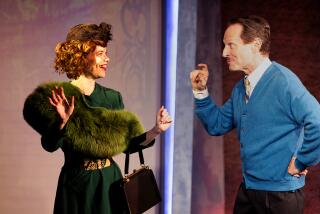MUSIC REVIEW : Rachel Rosenthal Guides E.A.R. Unit on an Amazon Safari : Diva: She remains a magnetic presence on the stage, even when her avant-garde vehicle falters.
- Share via
Rachel Rosenthal, the central attraction at the seasonal valedictory ventured Wednesday by the E.A.R. Unit at the Leo. S. Bing Theater, bills herself simply as a performance artist.
That’s about as accurate as calling the Taj Majal a house.
The woman is a monument, and a marvel. She is a force of nature. She materializes upon a stage, just sits in an ornate chair, and defies the observer not to be magnetized.
Her eyes glare with intense zeal. Her shaven skull gleams with defiant pride. Her mouth curls in passion mitigated, perhaps, by a trace of self-mockery.
When she moves, she really moves. Her arms rise in arcs of formidable defiance, whisking away invisible demons. Her fingers flick profoundly mysterious messages into the air, along with prosaic scraps of paper.
She insinuates a semblance of a samba. She flails into a mock arabesque. With ritualistic abandon, she swivels hips in transit. With crazed grace, she hurls her body at unseen enemies.
She recites a text that is sometimes intelligible despite primitive microphonic distortion. She keens. She croons. She roars.
She flits from mature Sprechgesang to the sing-song of an itty-bitty child’s voice. She takes off in fragmented flights of coloratura dementia, then dives bravely to basso-profondo grunts.
Rosenthal has been around. She knows the secrets of melody. She savors the force of rhythm. She observes the limitations of form. She exults in the dynamic fascination of theater.
She is timeless, ageless, gutsy, quirky, exotic, potentially poignant. She also is very clever.
She deserves a great showpiece. Unfortunately, “Amazonia,” which she has concocted in collaboration with the resident E.A.R. virtuosos, does not seem to be it. Not yet, anyway.
The elaborate four-part piece surrounds the diva with a lot of exotic trappings. Slide shows depict jungle paintings by Henri Rousseau and, at the other extreme of innocence, fanciful drawings by children aged 6 to 9.
Four accompanying performers--Arthur Jarvinen, Amy Knoles, Robin Lorentz and Dorothy Stone--stalk the boards. They chant, play with nonsense syllables, toy with home-made percussion instruments, pour water from bowl to amplified bowl, crinkle cellophane, manipulate folk symbols and strike picturesque poses.
All this is done in support of a Message--yes, capital M . The Brazilian rain forest must be saved.
Fervently protesting ecological waste, Rosenthal champions a noble, multi-layered cause. In the convoluted process, she invokes geological and biological history, recounts myths and stacks metaphors.
Some of her images--verbal, musical and dramatic--are specific. Some are abstract. Some seem organic to the narrative. Others seem merely decorative. Some must be significant, others pretentious.
“Amazonia” meanders too much to muster a profound artistic statement, much less a profound socio-political argument. It does, however, serve to focus the talent of a fascinating creative artist. In this day of delirious dilettantism, one must be grateful.
The first half of the program, devoid of Rosenthal, proved less compelling.
Frederic Rzewski’s “Aerial Tarts” (1990) turned out to be an amiable “rock-out” piece (whatever that means) in which seven busy musicians speak, sing and play a chancy, semi-parodistic game about the pie in the sky. It offered orderly sight gags accompanying happy sonic confusion, with pop accents masking political undertones.
Milton Babbitt’s “Consortini” (1989) replaced the originally scheduled premiere by Errki-Sven Tuur. Babbitt, born in 1916, volunteered his own program note for this taut, eminently cerebral exercise:
“The solos, duos, trios and quartets of the five concertino sections are intercalated with, framed by, the six tutti statements, and derive their content entirely, if in multiple interpretations, from the material of the tutti sections. The resulting similarities are moderated by registral, instrumental, dynamic, and tempo transformations in new contrapuntal and harmonic environments, while the tutti sections, progressively if discretely, change their function, their reference, from the proleptic to the retrospective, while yet constituting an autonomous, though interrupted, structural continuity.”
That helped a lot.
More to Read
The biggest entertainment stories
Get our big stories about Hollywood, film, television, music, arts, culture and more right in your inbox as soon as they publish.
You may occasionally receive promotional content from the Los Angeles Times.










